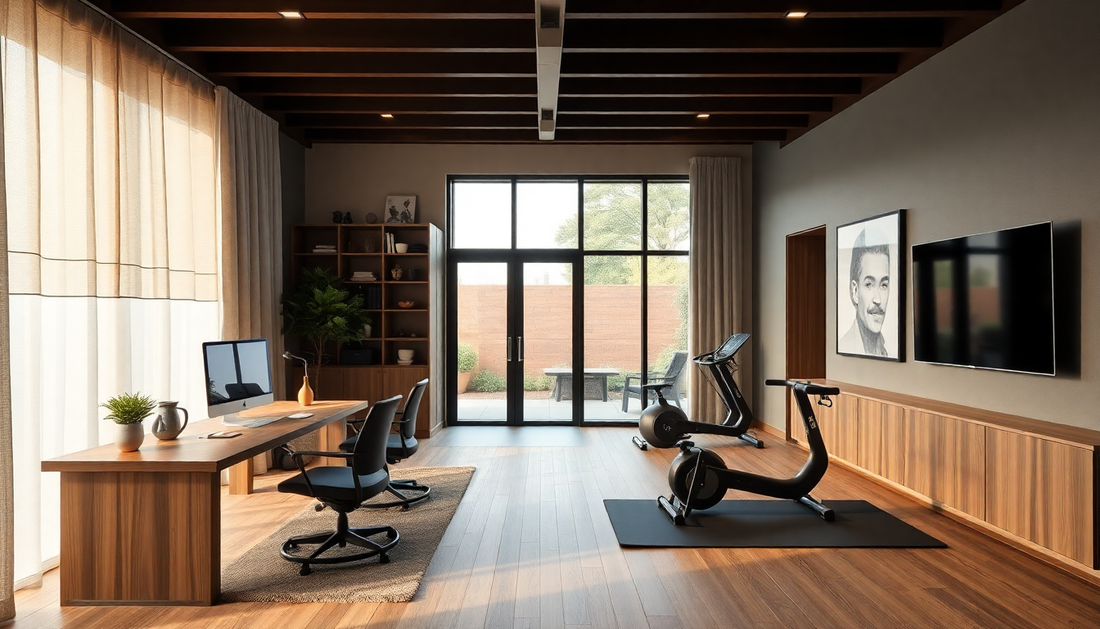Innovative Design Concepts for a Productive Home Office and Fitness Area in 2025: Achieve Your Best Work-Life Balance

Introduction
As we step into 2025, the importance of creating a harmonious balance between work and wellness in our homes has never been more crucial. The rise of remote work and a focus on personal health have led to innovative design concepts that seamlessly integrate a productive home office with a fitness area. In this article, we will explore the latest trends and ideas to help you achieve your best work-life balance, enhancing both productivity and personal well-being.
1. Multi-Functional Spaces
One of the most innovative design concepts for 2025 is the creation of multi-functional spaces. By maximizing the utility of your home, you can create environments that encourage productivity while promoting physical activity. Here are some ideas:
- Convertible Furniture: Invest in desks that can transform into standing workstations or fitness benches that double as seating. This dual-purpose furniture allows you to switch between work and exercise seamlessly.
- Flexible Layouts: Use movable partitions to create separate zones for work and fitness, allowing for quick transitions between tasks. With the right design, you can easily convert your workspace into a yoga studio.
- Integrated Technology: Equip your home office with smart devices that can track your fitness goals and productivity metrics. This integration can help you stay accountable to both your work and fitness routines.
Multi-functional spaces also encourage creativity and adaptability. You can rearrange your environment based on your daily needs, making your home dynamic and responsive to your lifestyle.
2. Natural Light and Airflow
Natural elements play a significant role in enhancing both productivity and well-being. In 2025, homes will increasingly emphasize the importance of natural light and airflow:
- Large Windows: Incorporate big windows or skylights to allow ample natural light into your workspace. Studies have shown that natural light improves mood and energy levels, which can boost productivity.
- Indoor Plants: Add greenery to your office and fitness area to improve air quality and create a calming atmosphere. Plants like snake plants and pothos not only beautify the space but also purify the air.
- Open Layouts: Design open spaces that facilitate the flow of air, making your working and workout environment more comfortable. Cross-ventilation can help maintain a pleasant temperature throughout the day.
When designing your home, consider the orientation of windows to maximize sunlight exposure during working hours. This can significantly improve your overall work experience.
3. Wellness-Centric Design
In 2025, the focus on wellness will extend beyond physical fitness. Consider these wellness-centric design concepts:
- Zen Zones: Create a meditation corner or a quiet reading nook to encourage mental relaxation. This space can serve as a retreat when you need to step away from work.
- Soundproofing: Invest in soundproofing materials to minimize distractions during work or workouts. Acoustic panels or sound-absorbing curtains can create a tranquil environment.
- Ergonomic Solutions: Choose ergonomic furniture that supports posture and reduces the risk of injury during long hours of work or exercise. Ergonomic chairs, sit-stand desks, and specialized equipment can enhance comfort.
Wellness-centric design not only improves physical health but also enhances mental clarity and focus. Including elements that promote relaxation can help reduce stress and improve overall productivity.
4. Technology Integration
Embracing technology is essential for a modern home office and fitness area. Here’s how to integrate tech effectively:
- Smart Home Devices: Use devices that adjust lighting and temperature to enhance focus and comfort. Smart thermostats and lighting systems can create an optimal working environment.
- Fitness Apps: Incorporate apps that can guide workouts and track progress, allowing for a seamless transition between work and fitness. Many apps offer personalization features to tailor workouts to your goals.
- Virtual Reality: Explore VR solutions that can provide immersive workout experiences or virtual meetings. VR can transport you to various environments, making workouts more engaging.
- Wearable Technology: Utilize smartwatches and fitness trackers to monitor your health metrics, such as heart rate and activity levels, ensuring you stay active during work hours.
By leveraging technology, you can create an integrated ecosystem that supports your productivity and fitness goals. This synergy can lead to a healthier and more efficient lifestyle.
5. Personalization
Finally, personalizing your space can significantly enhance your productivity and motivation:
- Color Psychology: Use colors that inspire creativity and calmness, such as blues and greens. Color selection can affect mood and productivity levels.
- Artwork and Decor: Display items that inspire you, whether it’s motivational quotes or artwork from your favorite artists. Personal touches can make your space feel more inviting.
- Personal Fitness Goals: Create a vision board that combines your work and fitness goals to keep you motivated. Visual reminders can keep you aligned with your aspirations.
Moreover, consider incorporating elements that reflect your personality, such as family photos or travel souvenirs. This can create a sense of belonging in your workspace.
6. Dedicated Areas for Mindfulness and Meditation
Incorporating spaces specifically designed for mindfulness and meditation can greatly enhance your work-life balance. These areas can serve as a refuge from the hustle and bustle of daily tasks:
- Quiet Rooms: Designate a room or corner in your home where you can practice mindfulness, meditate, or engage in deep breathing exercises.
- Calming Elements: Use soft lighting, comfortable seating, and soothing colors to create a calming atmosphere. Consider including a small water feature or aromatherapy diffusers to enhance relaxation.
- Mindfulness Tools: Integrate tools like meditation cushions, yoga mats, or stress-relief items that can help you decompress during breaks.
Creating a dedicated space for mindfulness not only improves mental health but also boosts overall productivity by allowing you to recharge effectively.
7. Outdoor Integration
As the trend towards biophilic design continues to grow, integrating outdoor spaces with your home office and fitness area can provide fresh air and a sense of connection with nature:
- Outdoor Workspaces: If possible, create an outdoor workspace that allows you to work in a natural setting. A patio or balcony with a desk can refresh your routine.
- Fitness in Nature: Design outdoor fitness areas with equipment like benches for calisthenics or open space for yoga and stretching. Exercising outdoors can elevate your mood and increase motivation.
- Gardening Opportunities: Consider setting up a small garden that can act as a peaceful retreat and provide fresh produce for a healthy diet.
Outdoor integration not only enhances aesthetics but also promotes a healthier lifestyle, encouraging you to step outside and enjoy the benefits of nature.
8. Community and Social Spaces
Incorporating communal areas into your home can foster social interactions, which are essential for mental well-being:
- Collaborative Spaces: If you share your home with family or roommates, create spaces that encourage teamwork, such as a communal table for brainstorming sessions or shared workouts.
- Fitness Classes at Home: Design an area for virtual fitness classes where you can engage with friends or family while exercising. This can make workouts more enjoyable and motivate you to stay active.
- Social Zones: Create comfortable areas where you can unwind with others, such as a lounge with seating for casual meetings or relaxation.
Engaging with others in your home environment can enhance motivation and create a supportive community atmosphere.
Conclusion
As we navigate the evolving landscape of 2025, the integration of a productive home office with a fitness area is paramount for achieving a healthy work-life balance. By embracing innovative design concepts such as multi-functional spaces, natural elements, wellness-centric features, technology integration, and personalization, you can create an environment that fosters both productivity and well-being. Start transforming your home today, and watch how it positively impacts your work and fitness journey. The future of home design is here, and it’s all about enhancing your life through thoughtful integration of work and wellness.
